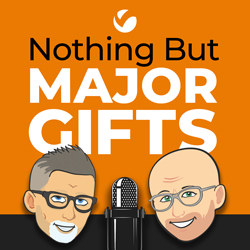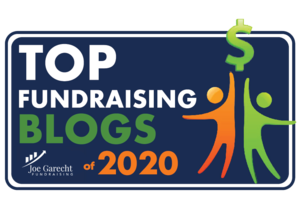
Letting go… it’s not always easy, is it? Anyone who has had to take her child to college or end a relationship knows that saying goodbye is never easy.
It’s also not easy for you as a major gift officer when a donor whom you have been stewarding and cultivating over time no longer meets the criteria to be included in a major gift program. Richard, our team and I see this dynamic quite a bit when we first start working with a new organization.
Many times, we’ll see major gift officers with 200, 300 or even 500 donors as part of their portfolios. When we tell the major gift officers they are going to have to pare that down to 150 donors, they are shocked!
“But these are MY donors,” one will plead. “You can’t take them off of my caseload, they really like me. They won’t give if I’m not their MGO.” But when we dig into the donor’s giving history, we find that they are no longer giving at a level that justifies their being on a caseload.
The MGO has to let them go.
In cases where MGOs have way more than 150 donors in their portfolios, it’s much easier to pare down their lists, versus an MGO who has 150 donors in his portfolio (as he should), but there are donors “waiting in the wings” who actually have more capacity and propensity to give.
This is where we get into some fairly tense discussions about the responsibility of the MGO both to the donors as well as to the organization. In many cases an MGO does not want to “give up” one of his donors for a new donor who has either greater value or much higher potential, because he has spent time nurturing that donor along.
I get that. But usually I find that the MGO doesn’t want to give up a donor because he feels some personal connection, or for some reason he thinks he has failed by not moving that donor up. This is where we have to remind the MGO that these donors are not “his” donors. They belong to the organization. And because of that, the organization has to use its resources in a responsible manner.
As much as we want to believe that all donors in the donor base are equal, the fact is that they are not. Especially in major gifts, some donors are much more valuable to the organization than others.
Yet the cost to cultivate each of those donors is relatively the same. I say relatively, because you do spend more time on some donors than others, but there are some donors on your file today that you simple can’t justify the expense for an MGO to cultivate them. So to keep a low-performing donor on a caseload because you are emotionally tied to that person or you feel bad, that is not being a good steward of your organization’s resources.
Here is some practical advice on the process of letting go of donors in your portfolio:
- Quarterly check-in meetings with your manager — In this meeting, go over donors that are either not performing, have told you they will not be giving and/or discuss donors that may be in jeopardy. They will go on your “watch list.” This will help you to spend a little more time on them and help you to decide if they will be staying in your portfolio.
- Semi-annual handoffs — Twice a year, Veritus recommends making decisions about taking donors off your caseload and adding new qualified donors that have more capacity and propensity to give. If your organization has a mid-level program, those donors you take off your caseload should move into that program.
- Moving a donor to a new MGO — While some donors coming off a caseload will be put back into your regular or mid-level donor program, some donors may move to another MGO. In that case, the best way to handle that situation is to have the former MGO write a cover letter introducing the new MGO and (depending upon the relationship) either participate in a call with the new MGO or have the new MGO follow up on her own to introduce herself.
While it’s difficult sometimes to say goodbye to a donor, it’s part of the work that great MGOs have to do. It’s all about creating the strongest portfolio you can, and using your organization’s resources wisely. Ultimately, it’s in the best interest of your donors. So schedule that quarterly review today, and start examining your portfolio.
Who do you need to say goodbye to?
Jeff






This is a great post. I’m curious about the flip side.
I’ve been in annual giving for nearly 10 years. Recently, we have developed a pipeline to identify and qualify our mid-level (leadership annual donors) more proactively. If MG inclination and propensity is known and shown, we pass the information and the prospect to our MGOs – even if AG has maintained and fostered the relationship.
Should mid-level officers remain a contact for the elevated donor and in what capacity? We are about building relationships – but once we pass the so-called buck – the relationship with the person is broken while maintaining a relationship with the organization and the cause.
Hi James, Thanks for writing. It’s great that you have created a mid-level program with mid-level reps. If you are passing a mid-level, Annual Fund donor on to and MGO to cultivate and steward the relationship should move to that MGO. However, there needs to be a staged pass off so that the donor is aware of the change. A letter from the mid-level rep, introducing the major gift officer is appropriate. Then, the MGO can follow up with a phone call to introduce themselves and possibly try to get a face to face meeting to get to know each other. It is important though that if a mid-level donor is passed off to an MGO that the MGO does cultivate that donor. Richard and I have seen situations where the donor is passed to an MGO and the MGO does not spend adequate time with the donor and the donor would have been better off treated by the mid-level rep. Usually the major gifts team is clamoring for more qualified donors so it’s not a problem, but something to be careful with. Remember, ultimately its about what is best for the donor.
Jeff,
I’m an MGO with many people in my portfolio who have been giving between $2,000 and $5,000 over the past 10 or 20 years. These folks have been hearing from me several times a year, or with some of them we have a practiced “dance” of an annual phone call at exactly the right time, in which they renew their support. I’m a devotee of the Veritus philosophy and I don’t believe these people should be in my portfolio. The only alternative, however, is a mid-level program that is not personalized. In that program these folks would never again receive an individualized communication or a phone call. My two questions: Knowing that, would you still advocate that I let them go? And if you answer yes, how do I explain that transition to the donor in a way that they won’t feel less important to the organization, and possibly reduce their level of giving or stop altogether?
Appreciate your thoughts and all of your great posts.
Hey Jim. Thanks for writing. What I don’t know is how many donors do you have on your current caseload of donors. If you are at 150 with no new qualified donors waiting in the wings or if you are under 150, it may be perfectly fine to have those donors on your caseload but have them as a Tier C level donor. That way, you can still focus most of your time on your A level donors and still have that occasional phone call or personal touchpoint with those C level donors. If, however, you have donors who have more capacity and inclination to give and are not on a caseload, I’d advise that you replace these donors. And, this is also why we advocate having a strong mid-level program that has a personal rep cultivating and stewarding between 600–750 donors on a caseload. The donors you described sound like a mid-level program is perfect for them. So, tell me more about your situation and I could be more specific about our recommendation.